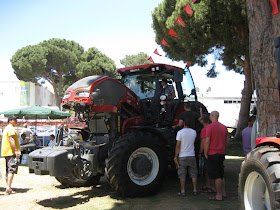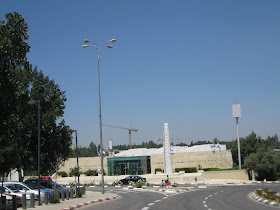.

Welcome to the Russian Orthodox Convent on the Mount of Olives.
Thursday, Ascension Day, was my first time to visit this welcoming place, also known as the Russian Monastery of the Ascension.
Now that I am one of Julie's many
Taphophile Tragics taphophiles, I paid special attention to the graves.
You can click on the photos to have a closer look.

A few tombs of VIPs were inside, or next to, the church, but there were more graves in the courtyard.

And some not far from the well.
The monastery was built between 1870 and 1887.
I think the old Made in Czechoslovakia Sigma pump is from those early days.
There are many underground cisterns in the big compound and it looks like some are still being used for the garden watering.


Many nuns were buried in a fenced graveyard.
I noticed some of the gravestones were "backwards," I mean facing the cross, facing eastward.
Now I knew that this monastery in the Arab village of A-Tur is the highest point on the Mount of Olives at 818 meters (2,683 ft)
and the ridge is the watershed, its eastern side being the beginning of the Judean Desert.
But I rather doubted that the spectacular view toward the Dead Sea, the mountains of Moab, and Jordan was the reason the dead were looking in that direction.
Back home, I googled.
One source said that Orthodox Christians bury the body facing east [i.e. the person's head on the west] because when Jesus was born the guiding star was in the East.
An older source, a
William Tyler Olcott, writing in 1914, explained the custom thus:
The funeral rites of all people reveal the universal belief that the east is the source of all that men hold dear, light, life, warmth, and happiness, while the west, on the contrary, is said to be the abode of darkness, death, cold, and sorrow. The worship of the Sun cultivated and strengthened this idea, and down through the ages the influence of this belief has swept, retaining even to-day much of its ancient force and vigour. . . .
It is said that the body of Christ was laid with the head toward the west, that the risen Lord might face the eastern realm of eternal life and glory, and the Christian custom that sprang from this belief led to the usage of digging graves east and west, which prevailed through mediæval times, and is common with us to-day.
In the twenty-fourth chapter of St. Matthew's gospel we read: "For as the lightning cometh out of the east, and shineth even unto the west; so shall also the coming of the Son of man be." From the literal interpretation of these words there arose the belief that Jesus would, at the resurrection, appear from the east, and hence that those buried with their faces upward and their heads to the west, would be in readiness to stand up with their faces toward their Judge.
.
(This cemetery mini-tour also joins
Our World Tuesday.)
.
 Later, when I left the Old City and walked near the city wall, I found the bikes--all one thousand of them!
Later, when I left the Old City and walked near the city wall, I found the bikes--all one thousand of them!
















































